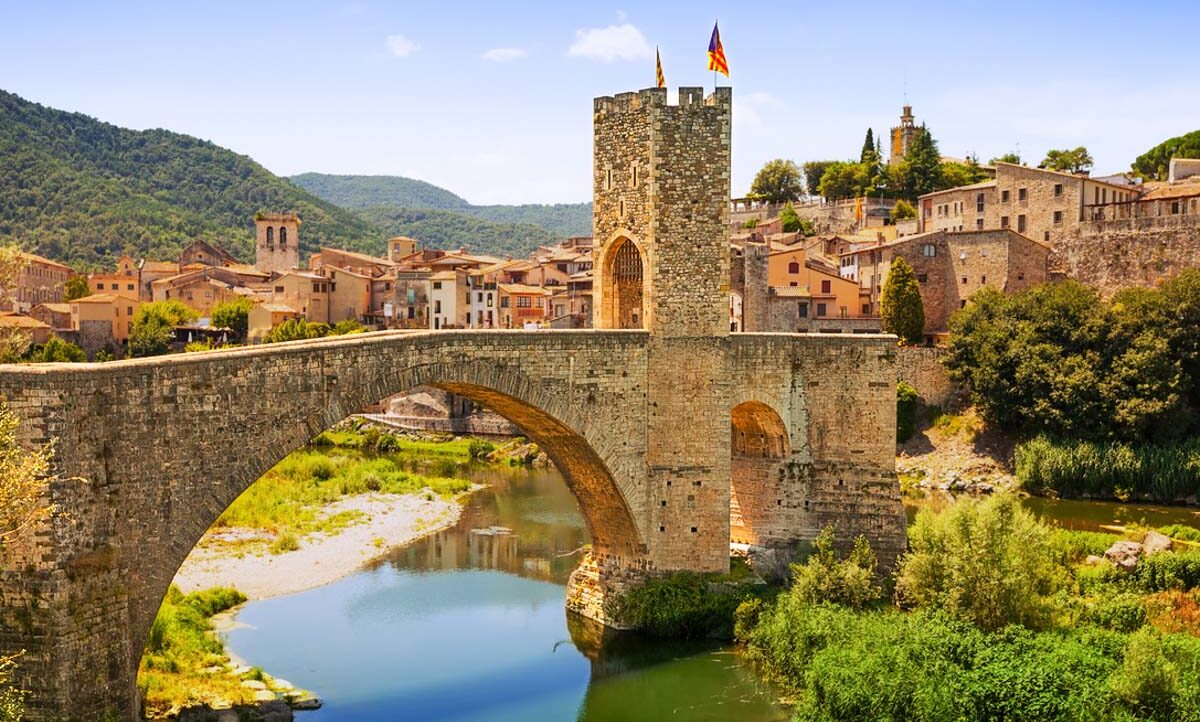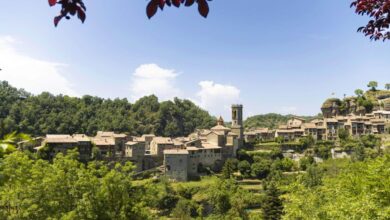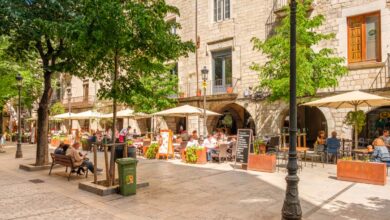
Besalú, a trip to medieval times
Besalú is a town in the province of Girona located between three regions: l’Alt Empordà, el Pla de l’Estany, and La Garrotxa. It is crossed by the Capellada River to the north and the Fluvià River to the south. Its medieval architecture stands out, dating back to the reign of Guifré el Pelós in the late 9th century when Besalú became an independent county that eventually became one of the most important in Catalonia.
Its territory extended from the valleys of Camprodon to Banyoles and Figueres, connecting agricultural and commercial lands with pastures. Currently, the primary economic activity is industry and tourism.
What to See
Learning about the history of the town of Besalú invites you to visit and witness an era that has left a lasting impact not only on this municipality but also on many other towns across the country.
The medieval style that characterizes Besalú makes it unique and special.

A significant starting point for your visit is the bridge that crosses the Fluvià River. It is a majestic stone bridge with eight arches. Built in the Romanesque style in the 12th – 14th centuries, it provided access to the fortifications of the county villa. It is classified as a national cultural heritage.

Upon entering the town, you will notice the medieval style of the municipality as you stroll through its cobbled streets and see the monuments, especially in the old town of Besalú. These monuments add great value and importance to the entire municipality, making it one of the best medieval showcases in all of Catalonia.
Continuing down the Old Bridge Street, you will come to a fork:

To the right is Maestro Abraham des Catllar Street. You might be intrigued by the iron chairs embedded in the stairs or hanging on the facades of buildings. These are sculptures created during an international meeting of young artists in Besalú in 1994. Some of the works created during this event became integrated into the landscape of Besalú.

You can continue to Rocafort Street, where you will find the Rocafort Gate, the ancient entrance to Besalú, where the 12-meter wall that surrounded the town along the river began. It is believed that its current appearance dates back to a 14th-century renovation, although it was originally built in the 11th century.

Right at the corner of the wall, you can climb to the bulwark of the wall, to the Mirador de Besalú, from where you can enjoy views of the lands that were part of the medieval county and see the entire layout of the town.
Going back, you can look for an old well in the same street. Take a detour to Força Street to see the arch of the Portal de la Força. It provided access to the Portal de la Força, the Visigothic fortified area, which was opened during the wall’s reconstruction when the castle was built.

To the left, if you don’t take the fork, is the Jewish Quarter. This is the Jewish Call where this community settled before being expelled in the 15th century.

There you will find the Placeta de los judíos, where the ancient Medieval Synagogue and the Jewish baths with a Micvé. The remains are very well preserved, and medieval-era documentation was also found. The ensemble is protected as a National Cultural Heritage.
 Down by the Fluvià River, you will find the Portalet Wall, a gate that closes off the walled enclosure.
Down by the Fluvià River, you will find the Portalet Wall, a gate that closes off the walled enclosure.

In both cases, continue along the Main Street to the Main Square or Liberty Square, the central square of the town, with vaults, where the Town Hall is located.

Continue straight to the end of the street, then turn right to find the Church-Hospital of Sant Julià, dating back to the 12th century. It was built by the counts of Besalú to care for pilgrims.
Continuing along Font Street, which follows a circular path, you will come across the Flour Mill d’en Subirós. Built in 977 by the same count for the benefit of the Monastery, it was used to grind grain using the hydraulic power of water.
Next, you will reach Prat de Sant Pere Square, where the Monastery of Sant Pere de Besalú is located, with Romanesque architecture and a Gothic bell tower.

Continuing forward, you will pass by Cornellà House or Llaudes House, one of the best-preserved Romanesque buildings in Catalonia. It was modified after its construction but still retains its oldest elements from the 12th century. It was built by one of the wealthiest families in Besalú, the Cornellà family. When it was purchased by the Llaudes family in 1476, they gave the house its current name. The building is part of the Inventory of Architectural Heritage of Catalonia.
There are still more religious buildings to see, one of them being the Church of Sant Vicent de Besalú, a little further up. It is a construction that combines Romanesque style with elements transitioning to Gothic. It was the former parish church of the town and houses the Gothic tomb of Pere de Rovira, who brought the relics of San Vicente to Besalú in 1413.

The other one is the Church of Santa Maria de Besalú, of which only a part of the apse remains. Originally, it was a simple chapel that became the seat of an Augustinian community in 1137, and it was also rebuilt as the castle church. Its bell tower was destroyed in 1938 during the Civil War.
The Castle of Besalú dates back to the 10th century and was built on the hill that holds remains of Santa Maria from the Middle Ages. The construction of different buildings allows visitors to imagine and place themselves in that era.
The foundations of the Round Tower are still preserved, built during the 11th century, as part of the castle’s defensive system.
A little further on is the Lardera Tower, about 9 meters in diameter, built using stone blocks. Its name appears in a document dated 1075.

Across the street is the Medieval House, an archaeological discovery of the ruins of a medieval dwelling where remains of ceramics, Roman tiles, fishing hooks, loom weights, and remnants of an iron lock were found.

On the other side of the road, around a picnic area, you will find the Church of Sant Martí de Capellada. It is a chapel from the 11th-17th centuries, featuring Romanesque architecture. It has a rectangular plan, an apse, and a bell tower, with a semi-circular arched entrance.

What to Do
In the town, there are numerous shops where you can buy gifts, souvenirs, or typical products.
Especially if you’re visiting with family, it might be a good idea to take the tourist train that travels through the cobbled streets and major medieval attractions. There is an urban route that runs every hour, free for children under 5, and a Romanesque route lasting 2 hours.

In Prat de Sant Pere Square, the same as the Monastery, you’ll find Circusland, a museum dedicated to the circus that was previously the Museum of Miniatures and Microminiatures of Besalú. You can also purchase a combined ticket with the train.
Finally, Besalú is known for its natural surroundings and agricultural lands. It features a green belt, and you can enjoy healthy walks along the banks of the Fluvià River. There are also some trails that were once used to reach neighboring villages. Moreover, it’s close to the Natural Park of the Garrotxa Volcanic Zone.

Gastronomy
The cuisine of La Garrotxa is rich in flavors and is characterized by the use of local ingredients in a region known for its volcanic terrain, abundant rainfall, and fertile soil. It primarily features dryland crops and forests.
As a result, it includes elements of mountain cuisine, such as mushrooms, snails, spices, and the use of grains. Notable legumes include fesols de Santa Pau and farro or farinetas de fajol. High-quality cured meats are also produced, with the butifarra and ham from Olot and Castellfollit being famous. In some bakeries, you can find Tortell entorxat d’Olot.

The quintessential traditional beverage is Ratafia, a liqueur made with walnuts and brandy, typical of the Catalan Pyrenees and especially the Garrotxa.
Where to Eat
Besalú is a great place to enjoy a meal, given the abundance of restaurants, taverns, cafés, and terraces it offers.
They mainly serve traditional Catalan, Mediterranean, and locally sourced cuisine: grilled meats, roasts, local sausages, various salads, and grilled fish, among other options. But you can find choices to suit all tastes and needs: pizzerias, brasseries, buffets, and celebration menus.
You can check out the restaurants in Besalú on Guiacat.
Where to Stay
In a village dedicated to tourism like Besalú, the accommodation options are plentiful and diverse. Within the walls, you can find a large number of hotels and apartments.
Outside the village and throughout the Garrotxa region, you’ll find many rural houses, rural hotels, and rural apartments ideal for various outdoor activities, such as walks or routes. They offer different features like swimming pools, fireplaces, or jacuzzis. In terms of location, they can be near the river, in the surroundings of the Fluvià River, or in the mountains, like the Natural Park of the Garrotxa Volcanic Zone.
You can find all rural accommodations in Garrotxa on Guiacat.
Local Festivals
The county town of Besalú celebrates its famous medieval fair, known as Besalú Medieval, in September. The town travels a thousand years back in time, giving its historic center an appearance characterized by medieval style that has always defined the region. Both the historical and architectural ensemble give the town a realistic atmosphere of the era, accompanied by shops and special decorations, as well as various activities for all ages.

During the Puente de la Purísima in December, the Ratafia Fair is celebrated, where a group of experts selects the best ratafia of the year from Besalú. The exhibition, tasting, and sale of ratafias from Catalonia take place in Liberty Square, and there’s also a market with typical and artisan products in Prat de Sant Pere Square.
Best Time to Visit
The best times to visit Besalú are spring and autumn as they are the most suitable for outdoor activities and mountain excursions. However, winter also offers a unique charm with Christmas decorations and the sale of nougat and hot chestnuts. In summer, the high tourist season may hide the essence of the town.
Must-See Attractions
- Stroll across the Old Bridge of Besalú.
- Explore the ancient Jewish Quarter.
- Visit the Monastery of Sant Pere.
- Discover the natural surroundings of Besalú.
What to See Nearby
You can visit the small surrounding towns: Sant Ferriol, Fares, Dosquers, Palera, its Sanctuary, Sant Pere de Lligordà, Beuda, and Maià de Montcal.
On the way to Olot, there’s also a charming village: Castellfollit de la Roca. Its uniqueness lies in its location on a basaltic cliff that’s 50 meters high.
 Castellfollit de la Roca
Castellfollit de la Roca
The capital of the region is Olot, a city located within the Natural Park of the Garrotxa Volcanic Zone. Seeing the dormant volcanoes in the park is an impressive experience that you shouldn’t miss. It’s also essential to take a walk through the exceptional environment of Fageda d’en Jordà, an area with diverse vegetation and rich natural heritage.
Finally, Besalú is very close to Banyoles, to the south. Don’t miss the opportunity to stroll around Banyoles Lake and discover its abundant flora and fauna.

How to Get There
By Road: From Girona to the south, it’s a 38-minute drive on the C-66 road. Taking the A-26, it’s 20 minutes from Olot. From Barcelona, it takes approximately 1 hour and 30 minutes, and it’s recommended to take the AP-7 highway. It’s about 2 hours and 20 minutes from Lleida via the C-25. To head towards the Pyrenees, you can take the Eje Pirinenc/N-260.
By Public Transport: Besalú is not well-connected for long journeys, but there is a TEISA bus that travels from Girona to Olot, passing through Banyoles, Besalú, Castellfollit de la Roca, etc.




